Ngan Luu-Thuy Nguyen
VLSP 2025 MLQA-TSR Challenge: Vietnamese Multimodal Legal Question Answering on Traffic Sign Regulation
Oct 23, 2025Abstract:This paper presents the VLSP 2025 MLQA-TSR - the multimodal legal question answering on traffic sign regulation shared task at VLSP 2025. VLSP 2025 MLQA-TSR comprises two subtasks: multimodal legal retrieval and multimodal question answering. The goal is to advance research on Vietnamese multimodal legal text processing and to provide a benchmark dataset for building and evaluating intelligent systems in multimodal legal domains, with a focus on traffic sign regulation in Vietnam. The best-reported results on VLSP 2025 MLQA-TSR are an F2 score of 64.55% for multimodal legal retrieval and an accuracy of 86.30% for multimodal question answering.
Coreference Resolution for Vietnamese Narrative Texts
Apr 28, 2025Abstract:Coreference resolution is a vital task in natural language processing (NLP) that involves identifying and linking different expressions in a text that refer to the same entity. This task is particularly challenging for Vietnamese, a low-resource language with limited annotated datasets. To address these challenges, we developed a comprehensive annotated dataset using narrative texts from VnExpress, a widely-read Vietnamese online news platform. We established detailed guidelines for annotating entities, focusing on ensuring consistency and accuracy. Additionally, we evaluated the performance of large language models (LLMs), specifically GPT-3.5-Turbo and GPT-4, on this dataset. Our results demonstrate that GPT-4 significantly outperforms GPT-3.5-Turbo in terms of both accuracy and response consistency, making it a more reliable tool for coreference resolution in Vietnamese.
An Attempt to Develop a Neural Parser based on Simplified Head-Driven Phrase Structure Grammar on Vietnamese
Nov 26, 2024Abstract:In this paper, we aimed to develop a neural parser for Vietnamese based on simplified Head-Driven Phrase Structure Grammar (HPSG). The existing corpora, VietTreebank and VnDT, had around 15% of constituency and dependency tree pairs that did not adhere to simplified HPSG rules. To attempt to address the issue of the corpora not adhering to simplified HPSG rules, we randomly permuted samples from the training and development sets to make them compliant with simplified HPSG. We then modified the first simplified HPSG Neural Parser for the Penn Treebank by replacing it with the PhoBERT or XLM-RoBERTa models, which can encode Vietnamese texts. We conducted experiments on our modified VietTreebank and VnDT corpora. Our extensive experiments showed that the simplified HPSG Neural Parser achieved a new state-of-the-art F-score of 82% for constituency parsing when using the same predicted part-of-speech (POS) tags as the self-attentive constituency parser. Additionally, it outperformed previous studies in dependency parsing with a higher Unlabeled Attachment Score (UAS). However, our parser obtained lower Labeled Attachment Score (LAS) scores likely due to our focus on arc permutation without changing the original labels, as we did not consult with a linguistic expert. Lastly, the research findings of this paper suggest that simplified HPSG should be given more attention to linguistic expert when developing treebanks for Vietnamese natural language processing.
Transformer-Based Contextualized Language Models Joint with Neural Networks for Natural Language Inference in Vietnamese
Nov 21, 2024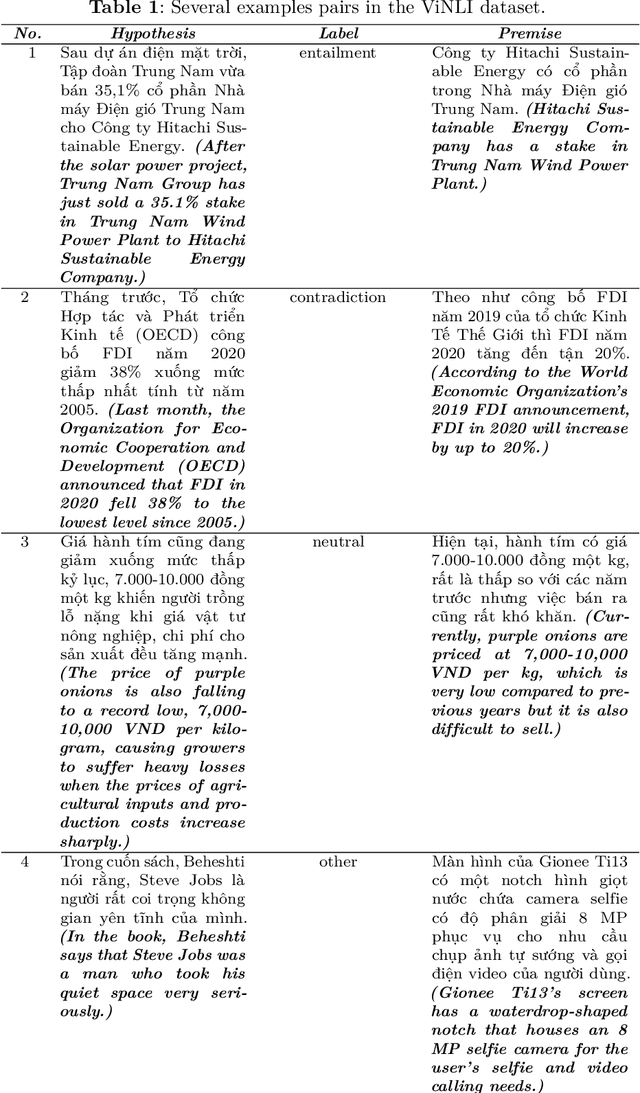
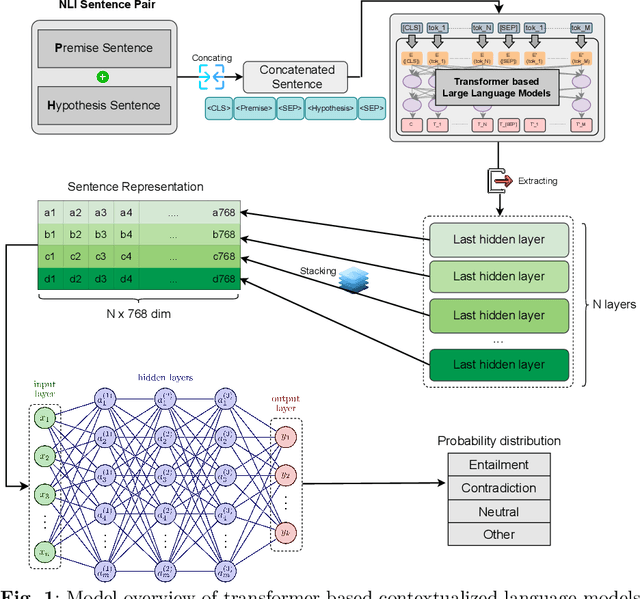
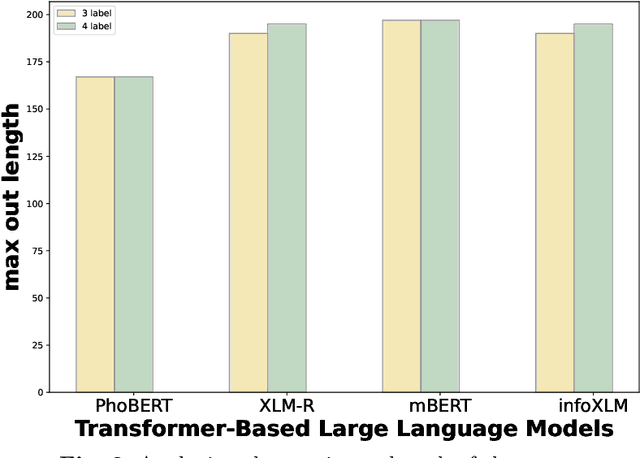
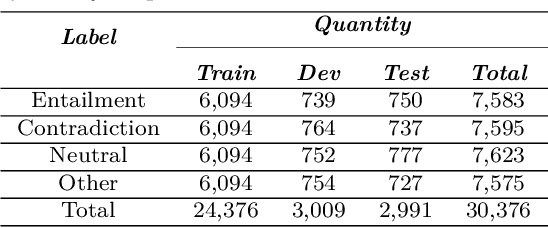
Abstract:Natural Language Inference (NLI) is a task within Natural Language Processing (NLP) that holds value for various AI applications. However, there have been limited studies on Natural Language Inference in Vietnamese that explore the concept of joint models. Therefore, we conducted experiments using various combinations of contextualized language models (CLM) and neural networks. We use CLM to create contextualized work presentations and use Neural Networks for classification. Furthermore, we have evaluated the strengths and weaknesses of each joint model and identified the model failure points in the Vietnamese context. The highest F1 score in this experiment, up to 82.78% in the benchmark dataset (ViNLI). By conducting experiments with various models, the most considerable size of the CLM is XLM-R (355M). That combination has consistently demonstrated superior performance compared to fine-tuning strong pre-trained language models like PhoBERT (+6.58%), mBERT (+19.08%), and XLM-R (+0.94%) in terms of F1-score. This article aims to introduce a novel approach or model that attains improved performance for Vietnamese NLI. Overall, we find that the joint approach of CLM and neural networks is simple yet capable of achieving high-quality performance, which makes it suitable for applications that require efficient resource utilization.
ViConsFormer: Constituting Meaningful Phrases of Scene Texts using Transformer-based Method in Vietnamese Text-based Visual Question Answering
Oct 24, 2024
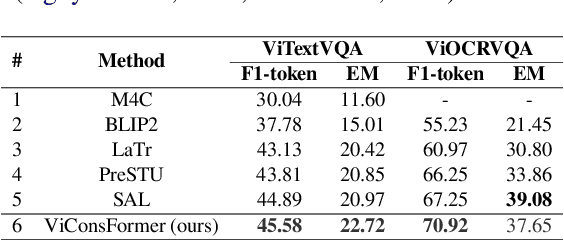
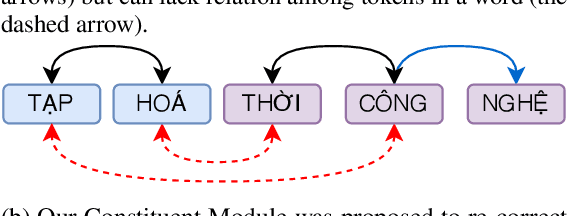
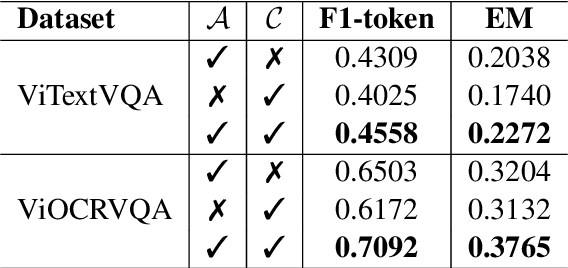
Abstract:Text-based VQA is a challenging task that requires machines to use scene texts in given images to yield the most appropriate answer for the given question. The main challenge of text-based VQA is exploiting the meaning and information from scene texts. Recent studies tackled this challenge by considering the spatial information of scene texts in images via embedding 2D coordinates of their bounding boxes. In this study, we follow the definition of meaning from linguistics to introduce a novel method that effectively exploits the information from scene texts written in Vietnamese. Experimental results show that our proposed method obtains state-of-the-art results on two large-scale Vietnamese Text-based VQA datasets. The implementation can be found at this link.
ViANLI: Adversarial Natural Language Inference for Vietnamese
Jun 25, 2024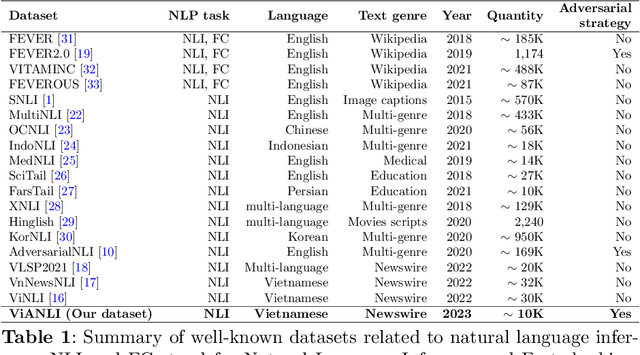
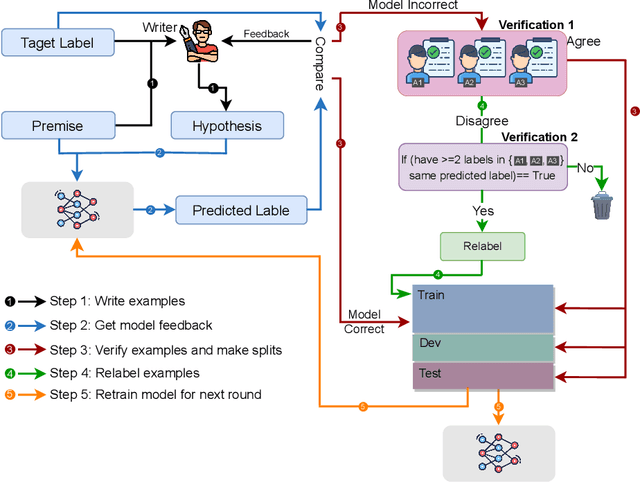

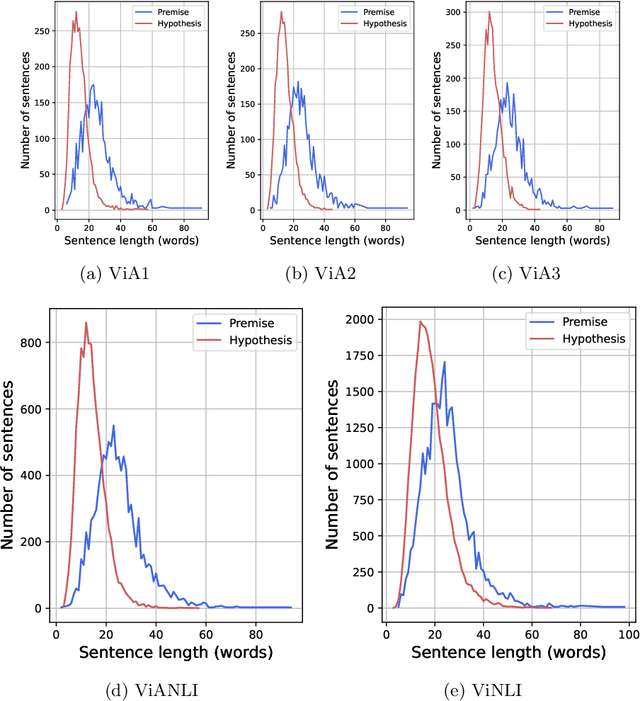
Abstract:The development of Natural Language Processing (NLI) datasets and models has been inspired by innovations in annotation design. With the rapid development of machine learning models today, the performance of existing machine learning models has quickly reached state-of-the-art results on a variety of tasks related to natural language processing, including natural language inference tasks. By using a pre-trained model during the annotation process, it is possible to challenge current NLI models by having humans produce premise-hypothesis combinations that the machine model cannot correctly predict. To remain attractive and challenging in the research of natural language inference for Vietnamese, in this paper, we introduce the adversarial NLI dataset to the NLP research community with the name ViANLI. This data set contains more than 10K premise-hypothesis pairs and is built by a continuously adjusting process to obtain the most out of the patterns generated by the annotators. ViANLI dataset has brought many difficulties to many current SOTA models when the accuracy of the most powerful model on the test set only reached 48.4%. Additionally, the experimental results show that the models trained on our dataset have significantly improved the results on other Vietnamese NLI datasets.
ViOCRVQA: Novel Benchmark Dataset and Vision Reader for Visual Question Answering by Understanding Vietnamese Text in Images
Apr 29, 2024



Abstract:Optical Character Recognition - Visual Question Answering (OCR-VQA) is the task of answering text information contained in images that have just been significantly developed in the English language in recent years. However, there are limited studies of this task in low-resource languages such as Vietnamese. To this end, we introduce a novel dataset, ViOCRVQA (Vietnamese Optical Character Recognition - Visual Question Answering dataset), consisting of 28,000+ images and 120,000+ question-answer pairs. In this dataset, all the images contain text and questions about the information relevant to the text in the images. We deploy ideas from state-of-the-art methods proposed for English to conduct experiments on our dataset, revealing the challenges and difficulties inherent in a Vietnamese dataset. Furthermore, we introduce a novel approach, called VisionReader, which achieved 0.4116 in EM and 0.6990 in the F1-score on the test set. Through the results, we found that the OCR system plays a very important role in VQA models on the ViOCRVQA dataset. In addition, the objects in the image also play a role in improving model performance. We open access to our dataset at link (https://github.com/qhnhynmm/ViOCRVQA.git) for further research in OCR-VQA task in Vietnamese.
ViTextVQA: A Large-Scale Visual Question Answering Dataset for Evaluating Vietnamese Text Comprehension in Images
Apr 16, 2024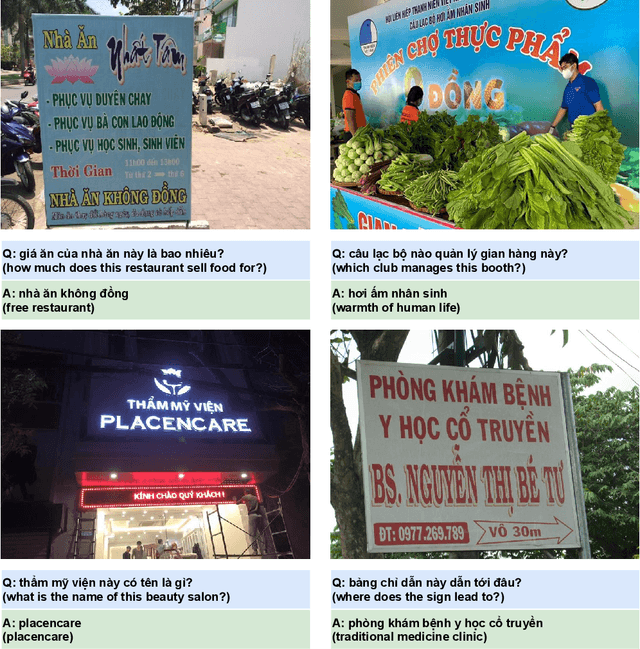



Abstract:Visual Question Answering (VQA) is a complicated task that requires the capability of simultaneously processing natural language and images. Initially, this task was researched, focusing on methods to help machines understand objects and scene contexts in images. However, some text appearing in the image that carries explicit information about the full content of the image is not mentioned. Along with the continuous development of the AI era, there have been many studies on the reading comprehension ability of VQA models in the world. As a developing country, conditions are still limited, and this task is still open in Vietnam. Therefore, we introduce the first large-scale dataset in Vietnamese specializing in the ability to understand text appearing in images, we call it ViTextVQA (\textbf{Vi}etnamese \textbf{Text}-based \textbf{V}isual \textbf{Q}uestion \textbf{A}nswering dataset) which contains \textbf{over 16,000} images and \textbf{over 50,000} questions with answers. Through meticulous experiments with various state-of-the-art models, we uncover the significance of the order in which tokens in OCR text are processed and selected to formulate answers. This finding helped us significantly improve the performance of the baseline models on the ViTextVQA dataset. Our dataset is available at this \href{https://github.com/minhquan6203/ViTextVQA-Dataset}{link} for research purposes.
VLUE: A New Benchmark and Multi-task Knowledge Transfer Learning for Vietnamese Natural Language Understanding
Mar 23, 2024Abstract:The success of Natural Language Understanding (NLU) benchmarks in various languages, such as GLUE for English, CLUE for Chinese, KLUE for Korean, and IndoNLU for Indonesian, has facilitated the evaluation of new NLU models across a wide range of tasks. To establish a standardized set of benchmarks for Vietnamese NLU, we introduce the first Vietnamese Language Understanding Evaluation (VLUE) benchmark. The VLUE benchmark encompasses five datasets covering different NLU tasks, including text classification, span extraction, and natural language understanding. To provide an insightful overview of the current state of Vietnamese NLU, we then evaluate seven state-of-the-art pre-trained models, including both multilingual and Vietnamese monolingual models, on our proposed VLUE benchmark. Furthermore, we present CafeBERT, a new state-of-the-art pre-trained model that achieves superior results across all tasks in the VLUE benchmark. Our model combines the proficiency of a multilingual pre-trained model with Vietnamese linguistic knowledge. CafeBERT is developed based on the XLM-RoBERTa model, with an additional pretraining step utilizing a significant amount of Vietnamese textual data to enhance its adaptation to the Vietnamese language. For the purpose of future research, CafeBERT is made publicly available for research purposes.
VlogQA: Task, Dataset, and Baseline Models for Vietnamese Spoken-Based Machine Reading Comprehension
Feb 05, 2024



Abstract:This paper presents the development process of a Vietnamese spoken language corpus for machine reading comprehension (MRC) tasks and provides insights into the challenges and opportunities associated with using real-world data for machine reading comprehension tasks. The existing MRC corpora in Vietnamese mainly focus on formal written documents such as Wikipedia articles, online newspapers, or textbooks. In contrast, the VlogQA consists of 10,076 question-answer pairs based on 1,230 transcript documents sourced from YouTube -- an extensive source of user-uploaded content, covering the topics of food and travel. By capturing the spoken language of native Vietnamese speakers in natural settings, an obscure corner overlooked in Vietnamese research, the corpus provides a valuable resource for future research in reading comprehension tasks for the Vietnamese language. Regarding performance evaluation, our deep-learning models achieved the highest F1 score of 75.34% on the test set, indicating significant progress in machine reading comprehension for Vietnamese spoken language data. In terms of EM, the highest score we accomplished is 53.97%, which reflects the challenge in processing spoken-based content and highlights the need for further improvement.
 Add to Chrome
Add to Chrome Add to Firefox
Add to Firefox Add to Edge
Add to Edge